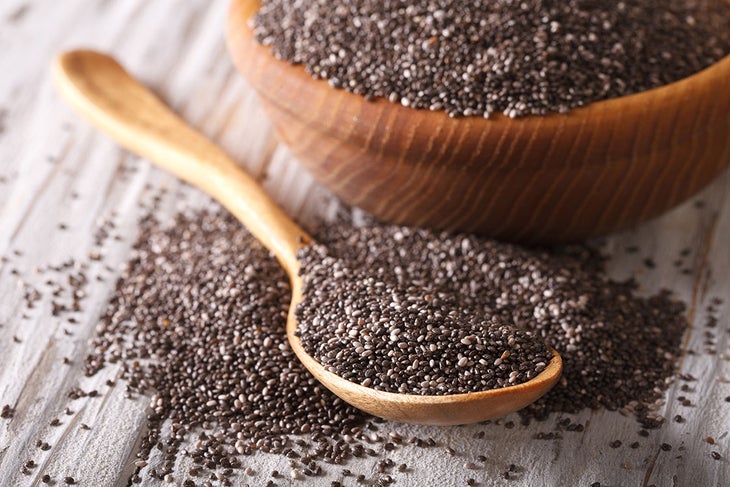Heading out the door? Read this article on the new Outside+ app available now on iOS devices for members! Download the app.

Prized for centuries as a superfood by the ancient Aztecs of Mexico, chia was nearly wiped out by the Spanish conquistadors, only to be hawked in recent memory as a novelty product, to the tune of Ch-ch-ch-chia!
How It Heals
Lately, the seeds of the Salvia hispanica plant are experiencing something of a renaissance as a functional food. Word is spreading of chia seeds’ copious amounts of heart-healthy omega-3 fats—”higher than many other foods,” says Wayne Coates, PhD, coauthor of Chia: Rediscovering a Forgotten Crop of the Aztecs. Research published in Diabetes Care suggests chia can help lower blood pressure and combat potentially heart-damaging inflammation.
Chia seeds are also chock-full of fiber, which has been credited with preventing weight gain and reducing diabetes risk. “Chia’s abundant soluble fiber forms a gel in the stomach, which slows food digestion, helping decrease blood sugar levels and promote satiety,” says Coates.
Add to chia’s benefits impressive amounts of chronic-disease-fighting antioxidants and the bone-building trio of calcium (about six times the amount in milk), magnesium, and phosphorus.
Eat It Up
Make a habit of adding at least 1 to 2 tablespoons of chia daily to your diet. According to Coates, there are no real restrictions on chia intake. “Most people can eat a cup a day without a problem,” he says. If you’re not used to eating a lot of dietary fiber, you may want to build up slowly to limit gastrointestinal distress.
The best evidence suggests black and white varieties of chia are equally nutritious. And unlike flax, the seeds don’t need to be ground up to access their healing benefits. “Chia also has a longer shelf life than flax, because the higher levels of antioxidants prevent the volatile oils from going rancid,” says Coates. Still, it’s best to refrigerate whole chia seeds.
Mix the seeds into yogurt, salads, smoothies, quick bread batters, veggie burger patties, and your favorite cereal to add satisfying crunch without altering flavor. Or take advantage of chia’s ability to absorb several times its weight in water, and whip up a tapioca-like gel to thicken puddings, sauces, fruit spreads, or dips: add ı/3 cup of seeds to 2 cups of water; stir gently with a wire whisk off and on for 5 minutes to prevent clumping, and store in a sealed container in the fridge. For vegan baking, 1/4 cup of chia gel acts as an egg replacer.
To boost the nourishing goodness of homemade muffins or pancakes, substitute chia powder for one-quarter of the flour called for in a recipe. Packages of 100 percent chia powder are available, but you can easily make your own by grinding whole seeds in a coffee grinder.
Raw Chocolate-Chia Energy Bars
Supplement Savvy
Look for chia oil supplements that contain at least 300 milligrams of omega-3 fats per veg cap; take one or two per day with meals. Keep the supplements refrigerated to avoid rancidity.